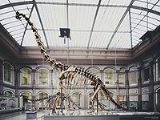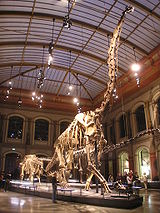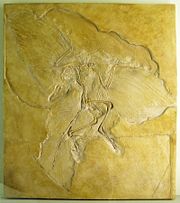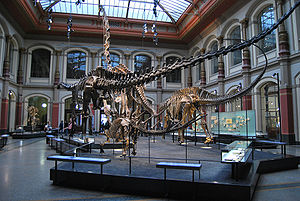
Humboldt Museum
Encyclopedia
The Museum für Naturkunde, officially the (Museum für Naturkunde – Leibniz Research Institute for Evolution and Biodiversity at the Humboldt University Berlin) or Naturkundemuseum (Natural History Museum), occasionally known as the Humboldt Museum, is a natural history museum in Berlin
, Germany
. Usually the museum's name is abbreviated MFN. The museum houses more than 30 million zoological, paleontological, and mineralogical specimens, including more than ten thousand type specimens. It is famous for two spectacular exhibits: the largest mounted dinosaur
in the world, and an exquisitely preserved specimen of the earliest known bird
, Archaeopteryx
.
Established in 1810, this is the largest museum of natural history in Germany. The museum's mineral
collections date back to the Prussian Academy
in 1700. Zoological specimens were recovered for example by the German deep-sea Valdiva expedition (1898–99), by the German Southpolar Expedition (1901–03), and by the German Sunda Expedition (1929–31). Expeditions to fossil
beds in Tendaguru
in former Deutsch Ostafrika (today Tanzania
) unearthed rich paleontological treasures. The collections are so extensive that less than 1 in 5000 specimens is exhibited, and they attract researchers from around the world.
Additional exhibits include a mineral
collection representing 75% of the minerals in the world, a large meteor
collection, the largest piece of amber
in the world; exhibits of the now-extinct quagga
and tasmanian tiger
, and "Bobby" the gorilla
, a Berlin Zoo celebrity from the 1920s and 1930s.

 Since the museum renovation in 2007, a large hall explains biodiversity and the processes of evolution, while several rooms feature regularly changing special exhibitions.
Since the museum renovation in 2007, a large hall explains biodiversity and the processes of evolution, while several rooms feature regularly changing special exhibitions.
brancai in the central exhibit hall is the largest mounted dinosaur skeleton in the world.
It is composed of fossilized bones recovered by the German paleontologist Werner Janensch
from the fossil-rich Tendaguru beds of Tanzania
between 1909 and 1913. The remains are primarily from one gigantic animal, except for a few tail bones (caudal vertebrae) which belong to another animal of the same size and species.
The mount is 12.72 m (41 ft 5 in) tall, and 22.25 m (73 ft) long (as of 2005). When living, the long-tailed, long-necked herbivore
probably weighed 50 t
(55 ton
s). While the Diplodocus carnegiei mounted next to it (a copy of an original from the Carnegie Museum of Natural History
in Pittsburgh
, United States
) actually exceeds it in length (27 m, or 90 ft), the Berlin specimen is taller, and far more massive.

s, claws, long lizard
-like tail, and the clear impression of feather
s in the surrounding stone is strong evidence of the link between reptile
s and birds. The Archaeopteryx is a transitional fossil
; and the time of its discovery was apt: coming on the heels of Darwin
's 1859 magnum opus, The Origin of Species
, made it quite possibly the most famous fossil in the world.
Recovered from the German
Solnhofen limestone
beds in 1871, it is only the third Archaeopteryx to be discovered and the most complete. The first specimen, a single 150 million year old feather found in 1860, is also in the possession of the museum.
was added.
By 1886 the university was overflowing with collections, so design began on a new building nearby at Invalidenstraße 43, which opened as the Museum of Natural History in 1889. The museum was built on the site of a former ironworks and this is reflected in two spectacular cast iron stairwells within the building.
Of particular significance is the contribution of the first director after the move to the new building. In the past the museum simply consisted of the entire collections being open to the public, but Karl Möbius
instigated a clear split between a public exhibition space with a few choice specimens, together with explanations of their relevance, and the remainder of the collection held in archives for scientific study.
The collections were damaged by the Allied
bombing of Berlin during World War II
. The eastern wing was severely damaged, and is only now in the process of being rebuilt. In 2011, the East Wing was rebuilt and now houses the partly publicly accessible entire alcohol collections.
In 1993, after the shake-up caused by the reunification of Germany, the museum split into the three divisions: The Institutes of Mineralogy, Zoology, and Paleontology. Infighting between the institute directors led to important changes in 2006, which saw the appointment of a Director General and the replacement of the former institutes by a division into Collections, Research and Exhibitions. Since January 1st, 2009 the Museum has officially separated from the Humboldt-University and become part of the Gottfried Wilhelm Leibniz Scientific Community as the Museum für Naturkunde – Leibniz Institute for Research on Evolution and Biodiversity at the Humboldt University Berlin . It is legally set up as a foundation.
Berlin
Berlin is the capital city of Germany and is one of the 16 states of Germany. With a population of 3.45 million people, Berlin is Germany's largest city. It is the second most populous city proper and the seventh most populous urban area in the European Union...
, Germany
Germany
Germany , officially the Federal Republic of Germany , is a federal parliamentary republic in Europe. The country consists of 16 states while the capital and largest city is Berlin. Germany covers an area of 357,021 km2 and has a largely temperate seasonal climate...
. Usually the museum's name is abbreviated MFN. The museum houses more than 30 million zoological, paleontological, and mineralogical specimens, including more than ten thousand type specimens. It is famous for two spectacular exhibits: the largest mounted dinosaur
Giraffatitan
Giraffatitan, meaning "giraffe titan", is a genus of sauropod dinosaur that lived during the late Jurassic Period . It was originally named as an African species of Brachiosaurus...
in the world, and an exquisitely preserved specimen of the earliest known bird
Bird
Birds are feathered, winged, bipedal, endothermic , egg-laying, vertebrate animals. Around 10,000 living species and 188 families makes them the most speciose class of tetrapod vertebrates. They inhabit ecosystems across the globe, from the Arctic to the Antarctic. Extant birds range in size from...
, Archaeopteryx
Archaeopteryx
Archaeopteryx , sometimes referred to by its German name Urvogel , is a genus of theropod dinosaur that is closely related to birds. The name derives from the Ancient Greek meaning "ancient", and , meaning "feather" or "wing"...
.
Established in 1810, this is the largest museum of natural history in Germany. The museum's mineral
Mineral
A mineral is a naturally occurring solid chemical substance formed through biogeochemical processes, having characteristic chemical composition, highly ordered atomic structure, and specific physical properties. By comparison, a rock is an aggregate of minerals and/or mineraloids and does not...
collections date back to the Prussian Academy
Prussian Academy
Prussian Academy may refer to:*Prussian Academy of the Arts, now the Akademie der Künste, Berlin*Prussian Academy of Sciences*Prussian Military Academy...
in 1700. Zoological specimens were recovered for example by the German deep-sea Valdiva expedition (1898–99), by the German Southpolar Expedition (1901–03), and by the German Sunda Expedition (1929–31). Expeditions to fossil
Fossil
Fossils are the preserved remains or traces of animals , plants, and other organisms from the remote past...
beds in Tendaguru
Tendaguru
The Tendaguru Beds are a fossil-rich formation in Tanzania. It has been considered the richest of Late Jurassic strata in Africa. Continental reconstructions show Tendaguru to have been in the southern hemisphere during the Late Jurassic. Tendaguru is similar to the Morrison Formation except in...
in former Deutsch Ostafrika (today Tanzania
Tanzania
The United Republic of Tanzania is a country in East Africa bordered by Kenya and Uganda to the north, Rwanda, Burundi, and the Democratic Republic of the Congo to the west, and Zambia, Malawi, and Mozambique to the south. The country's eastern borders lie on the Indian Ocean.Tanzania is a state...
) unearthed rich paleontological treasures. The collections are so extensive that less than 1 in 5000 specimens is exhibited, and they attract researchers from around the world.
Additional exhibits include a mineral
Mineral
A mineral is a naturally occurring solid chemical substance formed through biogeochemical processes, having characteristic chemical composition, highly ordered atomic structure, and specific physical properties. By comparison, a rock is an aggregate of minerals and/or mineraloids and does not...
collection representing 75% of the minerals in the world, a large meteor
METEOR
METEOR is a metric for the evaluation of machine translation output. The metric is based on the harmonic mean of unigram precision and recall, with recall weighted higher than precision...
collection, the largest piece of amber
Amber
Amber is fossilized tree resin , which has been appreciated for its color and natural beauty since Neolithic times. Amber is used as an ingredient in perfumes, as a healing agent in folk medicine, and as jewelry. There are five classes of amber, defined on the basis of their chemical constituents...
in the world; exhibits of the now-extinct quagga
Quagga
The quagga is an extinct subspecies of the plains zebra, which was once found in great numbers in South Africa's Cape Province and the southern part of the Orange Free State. It was distinguished from other zebras by having the usual vivid marks on the front part of the body only...
and tasmanian tiger
Thylacine
The thylacine or ,also ;binomial name: Thylacinus cynocephalus, Greek for "dog-headed pouched one") was the largest known carnivorous marsupial of modern times. It is commonly known as the Tasmanian tiger or the Tasmanian wolf...
, and "Bobby" the gorilla
Gorilla
Gorillas are the largest extant species of primates. They are ground-dwelling, predominantly herbivorous apes that inhabit the forests of central Africa. Gorillas are divided into two species and either four or five subspecies...
, a Berlin Zoo celebrity from the 1920s and 1930s.
Exhibitions


Dinosaur Hall
The specimen of GiraffatitanGiraffatitan
Giraffatitan, meaning "giraffe titan", is a genus of sauropod dinosaur that lived during the late Jurassic Period . It was originally named as an African species of Brachiosaurus...
brancai in the central exhibit hall is the largest mounted dinosaur skeleton in the world.
It is composed of fossilized bones recovered by the German paleontologist Werner Janensch
Werner Janensch
Werner Ernst Martin Janensch was a German paleontologist and geologist.Janensch's most famous contributions stemmed from the expedition he led with Edwin Hennig to the Tendaguru Beds in what is now Tanzania...
from the fossil-rich Tendaguru beds of Tanzania
Tanzania
The United Republic of Tanzania is a country in East Africa bordered by Kenya and Uganda to the north, Rwanda, Burundi, and the Democratic Republic of the Congo to the west, and Zambia, Malawi, and Mozambique to the south. The country's eastern borders lie on the Indian Ocean.Tanzania is a state...
between 1909 and 1913. The remains are primarily from one gigantic animal, except for a few tail bones (caudal vertebrae) which belong to another animal of the same size and species.
The mount is 12.72 m (41 ft 5 in) tall, and 22.25 m (73 ft) long (as of 2005). When living, the long-tailed, long-necked herbivore
Herbivore
Herbivores are organisms that are anatomically and physiologically adapted to eat plant-based foods. Herbivory is a form of consumption in which an organism principally eats autotrophs such as plants, algae and photosynthesizing bacteria. More generally, organisms that feed on autotrophs in...
probably weighed 50 t
Tonne
The tonne, known as the metric ton in the US , often put pleonastically as "metric tonne" to avoid confusion with ton, is a metric system unit of mass equal to 1000 kilograms. The tonne is not an International System of Units unit, but is accepted for use with the SI...
(55 ton
Ton
The ton is a unit of measure. It has a long history and has acquired a number of meanings and uses over the years. It is used principally as a unit of weight, and as a unit of volume. It can also be used as a measure of energy, for truck classification, or as a colloquial term.It is derived from...
s). While the Diplodocus carnegiei mounted next to it (a copy of an original from the Carnegie Museum of Natural History
Carnegie Museum of Natural History
Carnegie Museum of Natural History, located at 4400 Forbes Avenue in the Oakland neighborhood of Pittsburgh, Pennsylvania, USA, was founded by the Pittsburgh-based industrialist Andrew Carnegie in 1896...
in Pittsburgh
Pittsburgh, Pennsylvania
Pittsburgh is the second-largest city in the US Commonwealth of Pennsylvania and the county seat of Allegheny County. Regionally, it anchors the largest urban area of Appalachia and the Ohio River Valley, and nationally, it is the 22nd-largest urban area in the United States...
, United States
United States
The United States of America is a federal constitutional republic comprising fifty states and a federal district...
) actually exceeds it in length (27 m, or 90 ft), the Berlin specimen is taller, and far more massive.

Archaeopteryx
The "Berlin Specimen" of Archaeopteryx lithographica (HMN 1880), is displayed in the central exhibit hall. The dinosaur-like body with an attached tooth-filled head, wingWing
A wing is an appendage with a surface that produces lift for flight or propulsion through the atmosphere, or through another gaseous or liquid fluid...
s, claws, long lizard
Lizard
Lizards are a widespread group of squamate reptiles, with nearly 3800 species, ranging across all continents except Antarctica as well as most oceanic island chains...
-like tail, and the clear impression of feather
Feather
Feathers are one of the epidermal growths that form the distinctive outer covering, or plumage, on birds and some non-avian theropod dinosaurs. They are considered the most complex integumentary structures found in vertebrates, and indeed a premier example of a complex evolutionary novelty. They...
s in the surrounding stone is strong evidence of the link between reptile
Reptile
Reptiles are members of a class of air-breathing, ectothermic vertebrates which are characterized by laying shelled eggs , and having skin covered in scales and/or scutes. They are tetrapods, either having four limbs or being descended from four-limbed ancestors...
s and birds. The Archaeopteryx is a transitional fossil
Transitional fossil
A transitional fossil is any fossilized remains of a lifeform that exhibits characteristics of two distinct taxonomic groups. A transitional fossil is the fossil of an organism near the branching point where major individual lineages diverge...
; and the time of its discovery was apt: coming on the heels of Darwin
Charles Darwin
Charles Robert Darwin FRS was an English naturalist. He established that all species of life have descended over time from common ancestry, and proposed the scientific theory that this branching pattern of evolution resulted from a process that he called natural selection.He published his theory...
's 1859 magnum opus, The Origin of Species
The Origin of Species
Charles Darwin's On the Origin of Species, published on 24 November 1859, is a work of scientific literature which is considered to be the foundation of evolutionary biology. Its full title was On the Origin of Species by Means of Natural Selection, or the Preservation of Favoured Races in the...
, made it quite possibly the most famous fossil in the world.
Recovered from the German
Germany
Germany , officially the Federal Republic of Germany , is a federal parliamentary republic in Europe. The country consists of 16 states while the capital and largest city is Berlin. Germany covers an area of 357,021 km2 and has a largely temperate seasonal climate...
Solnhofen limestone
Solnhofen limestone
The Solnhofen Plattenkalk is a Jurassic Konservat-Lagerstätte that preserves a rare assemblage of fossilized organisms, including highly detailed imprints of soft bodied organisms such as sea jellies...
beds in 1871, it is only the third Archaeopteryx to be discovered and the most complete. The first specimen, a single 150 million year old feather found in 1860, is also in the possession of the museum.
Minerals Halls
The MFN's collection comprises roughly 250,000 specimens of minerals, of which roughly 4,500 are on exhibit in the Hall of Minerals.Evolution in action
A large hall explains the principles of evolution. It was opened in 2007 after a major renovation of parts of the building.History
Minerals in the museum were originally part of the collection of instructors from the Berlin Mining Academy. The University of Berlin was founded in 1810, and acquired the first of these collections in 1814, under the aegis of the new Museum of Mineralogy. In 1857, the paleontology department was founded, and 1854 a department of petrography and general geologyGeology
Geology is the science comprising the study of solid Earth, the rocks of which it is composed, and the processes by which it evolves. Geology gives insight into the history of the Earth, as it provides the primary evidence for plate tectonics, the evolutionary history of life, and past climates...
was added.
By 1886 the university was overflowing with collections, so design began on a new building nearby at Invalidenstraße 43, which opened as the Museum of Natural History in 1889. The museum was built on the site of a former ironworks and this is reflected in two spectacular cast iron stairwells within the building.
Of particular significance is the contribution of the first director after the move to the new building. In the past the museum simply consisted of the entire collections being open to the public, but Karl Möbius
Karl Möbius
Karl August Möbius was a German zoologist who was a pioneer in the field of ecology and a former director of the Museum für Naturkunde in Berlin.- Early life :...
instigated a clear split between a public exhibition space with a few choice specimens, together with explanations of their relevance, and the remainder of the collection held in archives for scientific study.
The collections were damaged by the Allied
Allies
In everyday English usage, allies are people, groups, or nations that have joined together in an association for mutual benefit or to achieve some common purpose, whether or not explicit agreement has been worked out between them...
bombing of Berlin during World War II
World War II
World War II, or the Second World War , was a global conflict lasting from 1939 to 1945, involving most of the world's nations—including all of the great powers—eventually forming two opposing military alliances: the Allies and the Axis...
. The eastern wing was severely damaged, and is only now in the process of being rebuilt. In 2011, the East Wing was rebuilt and now houses the partly publicly accessible entire alcohol collections.
In 1993, after the shake-up caused by the reunification of Germany, the museum split into the three divisions: The Institutes of Mineralogy, Zoology, and Paleontology. Infighting between the institute directors led to important changes in 2006, which saw the appointment of a Director General and the replacement of the former institutes by a division into Collections, Research and Exhibitions. Since January 1st, 2009 the Museum has officially separated from the Humboldt-University and become part of the Gottfried Wilhelm Leibniz Scientific Community as the Museum für Naturkunde – Leibniz Institute for Research on Evolution and Biodiversity at the Humboldt University Berlin . It is legally set up as a foundation.
External links
- Museum für Naturkunde (home page)
- Naturkundemuseum Berlin seeks sponsors for a hoard of world heritage treasures, by Eva-Maria Levermann from Goethe-Institut
- History of Humboldt-Universität zu Berlin
- Photo of the Berlin specimen of the Archaeopteryx
- History of the mineralogical collections at the Museum of Natural History in Berlin
- Time-lapse film of the dismantling of Brachiosaur
- History of the mineral collection

